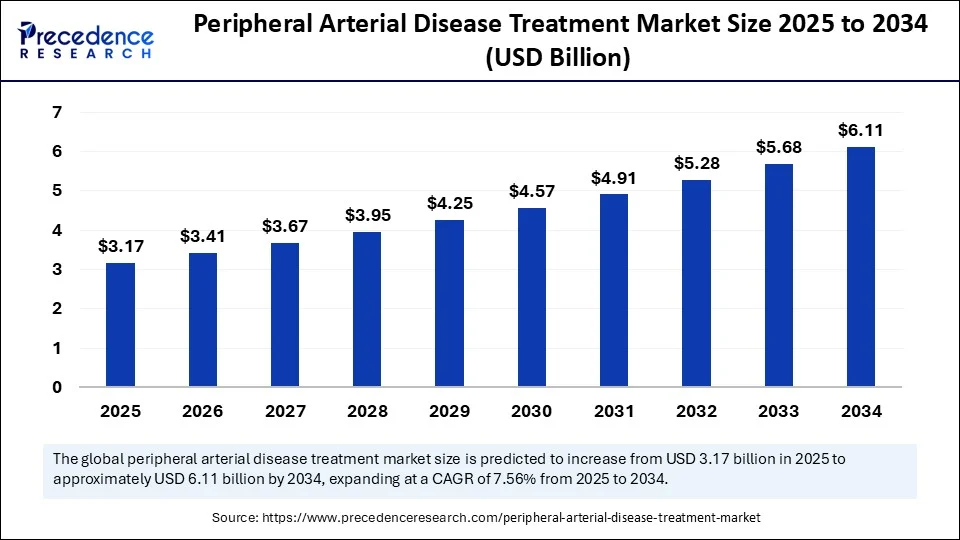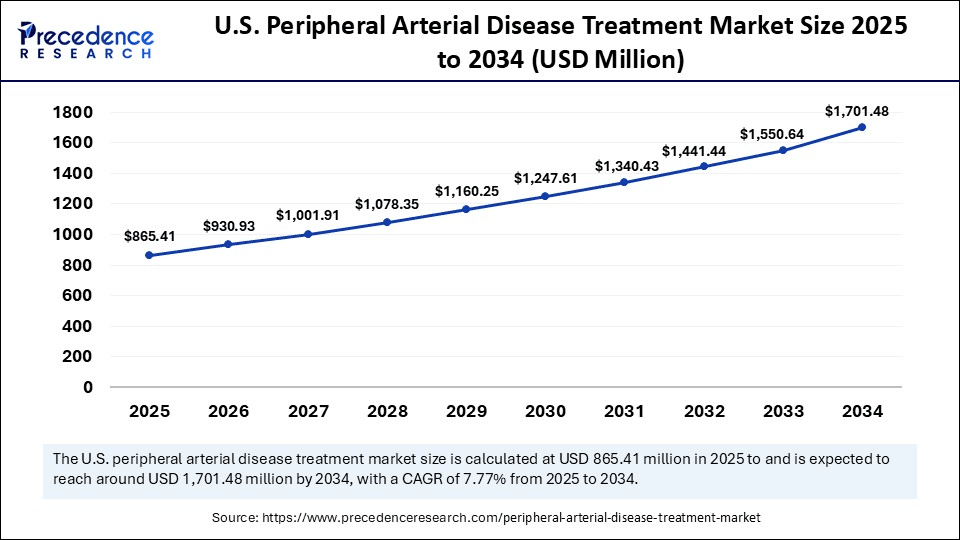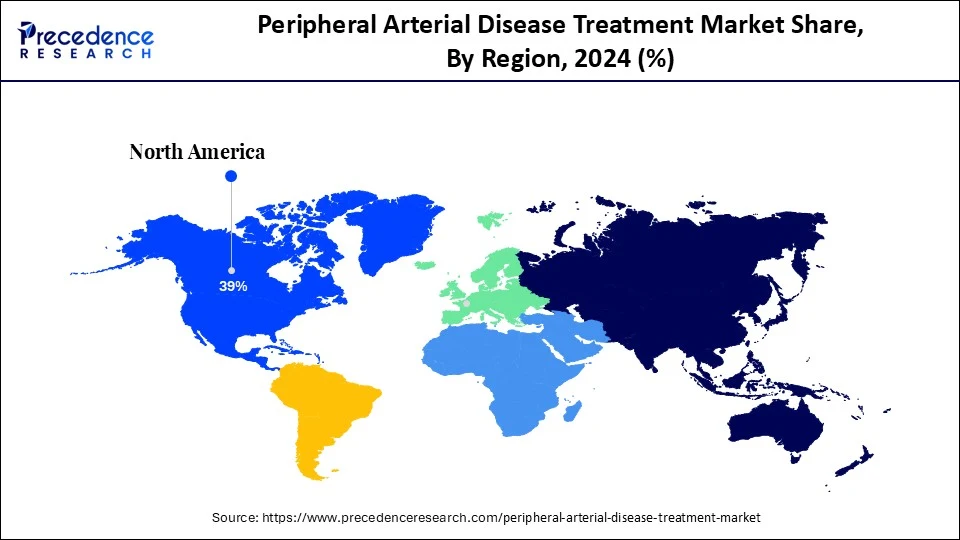List of Contents
Peripheral Arterial Disease Treatment Market Size and Forecast 2025 to 2034
The global peripheral arterial disease treatment market size accounted for USD 2.95 billion in 2024 and is predicted to increase from USD 3.17 billion in 2025 to approximately USD 6.11 billion by 2034, expanding at a CAGR of 7.56% from 2025 to 2034. The growth of the market is attributed to the rising disease prevalence, increased adoption of minimally invasive technologies, and ongoing innovation by leading medical device companies.

Peripheral Arterial Disease Treatment Market Key Takeaways
- The global peripheral arterial disease treatment market was valued at USD 2.95 billion in 2024.
- It is projected to reach USD 6.11 billion by 2034.
- The market is expected to grow at a CAGR of 7.56% from 2025 to 2034.
- North America dominated the peripheral arterial disease treatment market with the largest market share of 39% in 2024.
- Asia Pacific is expected to grow at the fastest CAGR in the coming years.
- By drug type, the antiplatelet drugs segment held the largest share of the market in 2024.
- By drug type, the vasodilators segment is expected to grow at the fastest CAGR during the forecast period.
- By route of administration, the oral segment led the market in 2024.
- By route of administration, the parenteral segment is expected to grow at the fastest CAGR in the upcoming period.
- By distribution channel, the hospital pharmacies segment contributed the biggest market share in 2024.
- By distribution channel, the online pharmacies segment is expected to grow at the fastest CAGR between 2025 and 2034.
How is Artificial Intelligence (AI) Transforming the Diagnosis and Management of Peripheral Arterial Disease (PAD)?
Artificial Intelligence is transforming the diagnosis and management of peripheral arterial disease (PAD) by enabling earlier detection, more accurate risk assessment, and personalized treatment strategies. While machine learning algorithms evaluate patient data to forecast PAD risk and progression, AI-powered imaging tools assist clinicians in more accurately and quickly identifying arterial blockages. By recommending the best course of treatment based on each patient's unique health profile, these technologies also assist clinicians in making decisions. Additionally, continuous remote monitoring made possible by AI integration with wearable technology promotes proactive intervention and better patient outcomes. Overall, artificial intelligence improves productivity, decreases diagnostic errors, and facilitates more timely and focused PAD care.
U.S. Peripheral Arterial Disease Treatment Market Size and Growth 2025 to 2034
The U.S. peripheral arterial disease treatment market size was exhibited at USD 805.35 billion in 2024 and is projected to be worth around USD 1,701.48 billion by 2034, growing at a CAGR of 7.77% from 2025 to 2034.

What Made North America the Dominant Region in the Peripheral Arterial Disease Treatment Market?
North America dominated the market by capturing the largest share in 2024. This is mainly due to the increased prevalence of cardiovascular diseases and the early uptake of cutting-edge therapeutic approaches. Strong awareness campaigns encouraging early diagnosis and intervention, favorable reimbursement policies, and sizable R&D investment all benefit the regional market. The availability of cutting-edge PAD therapies is greatly influenced by the large pharmaceutical companies that operate in the area. Furthermore, the availability of certified vascular centers and knowledgeable specialists guarantees that patients receive prompt and efficient care. The region's well-established healthcare system and high demand for home-based treatments are strengthening the region's position in the market.

Asia Pacific is expected to grow at the fastest CAGR in the coming year due to the aging population, rising rates of chronic illnesses, and continuous improvements in healthcare infrastructure and access. Regional market expansion is being propelled by increased investment in vascular care, improved diagnostic capabilities, and rising public awareness of peripheral arterial disease. Government health programs that focus on early screening and prevention further support market expansion. Additionally, greater access to treatment is being made possible by the growth of local manufacturing, digital healthcare platforms, and affordable therapies, which is accelerating the market growth. The rising healthcare expenditure in countries like India and China is likely to boost the demand for PAD treatments.
Europe is expected to grow at a notable rate in the peripheral arterial disease treatment market, driven by a strong focus on preventive cardiovascular care, advanced healthcare systems, and high disease awareness among both patients and practitioners. The region is recognized for its sizeable clinical research, the presence of leading academic hospitals, and favorable regulatory support for the approval and reimbursement of PAD therapies. In addition, collaborative efforts between public health authorities and private players are fostering early diagnosis and structured care pathways. The growing elderly population and demand for minimally invasive treatments further contribute to regional market growth.
Market Overview
The global peripheral arterial disease treatment market is experiencing steady growth, driven by the increasing prevalence of cardiovascular diseases worldwide and the growing use of less invasive treatment alternatives. The number of PAD cases is rising globally, driven by factors like aging populations, sedentary lifestyles, and unhealthy lifestyles like smoking and diabetes. This, in turn, creates the need for effective treatments to reduce the global burden. Technological innovations in devices such as drug-coated balloon stents and atherectomy systems are reducing recovery times and improving procedural success rates. Furthermore, improved screening programs and greater awareness of PAD in both developed and developing nations facilitate prompt intervention and earlier diagnosis. The global market for PAD treatment is anticipated to grow steadily over the course of the forecast period due to increased investment in vascular care, expanding healthcare access, and ongoing innovation.
Peripheral Arterial Disease Treatment MarketGrowth Factors
- Rising Prevalence of PAD: Increasing global cases are due to aging populations, sedentary lifestyles, smoking, diabetes, and hypertension.
- Early Diagnosis and Improved Screening Tools: Growth in the use of non-invasive diagnostics like ankle-brachial index (ABI), duplex ultrasound, and CT/MR angiography is leading to early detection.
- Shift Toward Minimally Invasive Procedures: High adoption of less invasive treatments such as angioplasty, drug-coated balloons (DCBs), stents, and atherectomy devices due to faster recovery and fewer complications.
- Technological Advancements in Treatment Devices: Continuous innovation in endovascular devices, including drug-eluting technologies, bioresorbable scaffolds, and image-guided systems.
- Expanding Healthcare Infrastructure in Emerging Economies: Growing investments in hospitals and clinics in countries across Asia-Pacific, Latin America, and the Middle East.
- Increased Public and Private Healthcare Spending: Supportive government initiatives, insurance coverage, and funding for non-communicable disease management programs.
- Rising Awareness Among Patients and Physicians: Educational campaigns and guideline updates are leading to better recognition and treatment of PAD.
Integration of Artificial Intelligence and Digital Health: AI-based tools enhance diagnosis, risk stratification, and remote monitoring capabilities.
Market Scope
| Report Coverage | Details |
| Market Size by 2034 | USD 6.11 Billion |
| Market Size in 2025 | USD 3.17 Billion |
| Market Size in 2024 | USD 2.95 Billion |
| Market Growth Rate from 2025 to 2034 | CAGR of 7.56% |
| Dominating Region | North America |
| Fastest Growing Region | Asia Pacific |
| Base Year | 2024 |
| Forecast Period | 2025 to 2034 |
| Segments Covered | Drug Type, Route of Administration, Distribution Channel, and Region |
| Regions Covered | North America, Europe, Asia-Pacific, Latin America, and Middle East & Africa |
Market Dynamics
Drivers
Shift Toward Minimally Invasive Treatment Options
The healthcare industry is rapidly moving away from open surgeries to minimally invasive procedures. Drug-coated balloons, atherectomy stenting, and balloon angioplasty are among the treatments that provide better patient outcomes, shorter recovery times, and fewer complications. Because both doctors and patients like these innovations, they are being adopted more widely. Next-generation PAD treatment tools like bioresorbable scaffolds and intravascular lithotripsy catheters are becoming more and more popular among businesses as they improve safety and clinical effectiveness. A major factor in market growth is the ongoing development of minimally invasive technologies.
Expansion of Healthcare Infrastructure in Emerging Economies
The expansion of healthcare facilities in emerging economies drives the growth of the peripheral arterial disease treatment market. Governments of emerging regions like the Middle East, Asia Pacific, and Latin America are investing heavily to modernize existing healthcare facilities and establish new ones, especially in rural areas. This, in turn, improves access to PAD diagnosis and treatment options. Patients are now able to access advanced PAD treatments thanks to increased government initiatives and supportive reimbursement policies.
Restraints
Limited Access in Rural and Low-Income Areas
Access to high-quality PAD treatments and advanced diagnostic tools is still limited, particularly in rural and economically weak areas. Many areas lack qualified interventional radiologists and cardiologists, as well as specialized vascular care facilities. Logistical difficulties, inadequate transportation infrastructure, and limited diagnostic capabilities further hamper early detection and prompt treatment. This discrepancy ultimately impedes the market's overall growth by contributing to a sizable patient base that remains undiagnosed and untreated.
Risk of Procedural Complications and Device Failures
Post-operative risks associated with interventional procedures hamper the growth of the peripheral arterial disease treatment market. During or after procedures, complications like thrombosis, vessel perforation of restenosis (re-narrowing of the arteries), and allergic reactions to contrast agents may arise. Clinical concerns can also arise from device-related problems such as stent migration fracture or incomplete deployment. These hazards frequently cause hesitancy in patients and doctors, particularly when dealing with high-risk patients or complicated arterial blockages. Moreover, the regulatory approval process for new medical devices and therapies can be time-consuming, delaying market entry and limiting access.
Opportunities
Advancements in Drug Coated and Bioresorbable Technology
A major opportunity in the peripheral arterial disease treatment market lies in the rising demand for next-generation PAD treatment technologies, particularly drug-coated balloons (DCBs), drug-eluting stents (DES), and bioresorbable scaffolds. These tools are intended to decrease restenosis rates and increase long-term vessel patency, both of which improve clinical results. Companies that invest in R&D for novel coatings delivery systems and resorbable materials can benefit from the growing demand for alternatives to traditional stenting and angioplasty. In addition, the rising demand for novel therapies like cell and gene therapies holds the potential to improve treatment outcomes.
Integration of Artificial Intelligence and Imaging Technologies
There is increasing potential for incorporating robotics, artificial intelligence (AI), and advanced imaging (such as OCT and IVUS) into PAD interventions and diagnosis. While robotic catheter systems can improve procedural safety and precision, AI-powered software can help with risk prediction, lesion detection, and treatment planning. High-volume facilities and specialty clinics may find these innovations appealing since they have the potential to lower operator variability and enhance clinical outcomes. Businesses can stand out in the market by investing in intelligent AI-integrated PAD treatment platforms.
Drug Type Insights
Why Did the Antiplatelet Drugs Segment Dominate the Peripheral Arterial Disease Treatment Market in 2024?
The antiplatelet drugs segment dominated the market with the largest share in 2024 because they are effective in lowering the risk of cardiovascular events and preventing blood clots. For PAD patients, particularly those with atherosclerotic blockages, medications such as clopidogrel and aspirin are frequently prescribed as first-line treatments. They are favored by healthcare providers due to their long history of clinical acceptance, affordability, and capacity to lower morbidity. Furthermore, their standard of care status is reinforced by robust clinical guidelines that support their use in both symptomatic and asymptomatic PAD. The segment growth is further reinforced by their extensive availability and high prescription volume.
The vasodilators segment is expected to grow at the fastest rate during the forecast period, as they are frequently used as a first-line treatment option for PAD, particularly in the early stage of the disease. Due to their proven effectiveness in dilating blood vessels, their preference is rising. Vasodilators help alleviate common symptoms like claudication (pain, cramping, or fatigue in the legs or arms during exercise), improving patient's quality of life. The rising demand for combination therapies further supports segmental growth.
Route of Administration Insights
How Does the Oral Segment Dominate the Market in 2024?
The oral segment dominated the peripheral arteria disease treatment market with a major share in 2024 due to its convenience and enhanced patient compliance. Oral administration is widely preferred in long-term disease management. Oral medications are generally more convenient for patients as they are easily accessible and can be incorporated into daily treatment routines. The demand for oral medications has increased due to the preference for noninvasive and self-administered medications. Oral drug delivery is also becoming safer and more effective thanks to innovations like controlled-release tablets. Moreover, advancements in drug formulations are improving bioavailability and extended-release properties, enhancing their effectiveness.
The parenteral segment is expected to grow at the fastest rate in the upcoming period, driven by rising demand for rapid and targeted drug delivery, especially in acute care. Parenteral administration allows for rapid onset of action, which is beneficial in PAD care, especially when immediate relief is required. Their precise control over dosage achieves optimal therapeutic effects, making them suitable for pre- as well as post-operative care of PAD. The use of injectables has increased due to improvements in their safety profile brought about by advancements in formulation and delivery methods. Additionally, the increasing popularity of mobile health units and outpatient infusion centers is boosting the accessibility of injectable drugs.
Distribution Channel Insights
Why Did the Hospital Pharmacies Segment Dominate the Peripheral Arterial Disease Treatment Market in 2024?
The hospital pharmacies segment dominated the market with the biggest share in 2024 because they are the main route via which vital drugs are administered during emergency care, surgery, and diagnosis. They maintain their top spot in the distribution network by providing direct physician supervision, injectable medications, and advanced therapies in hospital settings, all of which guarantee the best possible care and adherence. Hospital pharmacies also handle complicated cases that call for multi-drug regimens. Additionally, hospital pharmacies manage expensive PAD therapies more effectively thanks to centralized inventory systems and institutional purchasing agreements.
The online pharmacies segment is expected to grow at the fastest rate during the projection period, driven by growing telehealth adoption and preference for home healthcare. E-pharmacies provide patients with easy access to drugs like antiplatelets and strains. The online channel is expanding quickly in both urban and rural markets thanks to improved regulatory frameworks, prescription compliance, and digital payment options. The COVID pandemic also hastened the transition to e-pharmacy platforms by normalizing their use across all demographic groups. Online pharmacies frequently provide online consultations with doctors, eliminating the need to visit hospitals. This convenience attracts more patients. Moreover, these pharmacies often provide drugs at discounted prices and offer home delivery, making them beneficial for patients in remote areas.
Peripheral Arterial Disease Treatment Market Companies

- Bayer AG
- Pfizer Inc
- Eli Lilly and Company
- Cipla
- Lupin
- Viatris Inc
- Johnson & Johnson
- Sonafi
- Novartis AG
- Amgen Inc.
- Aurobindo Pharma
Latest Announcement by Industry Leader
- In May 2025, Reflow Medical announced U.S. FDA De Novo clearance of its Spur Peripheral Retrievable Stent System for the treatment of de novo or restenotic lesions after predilatation in patients with infrapopliteal arterial disease. The Spur stent system features a self-expanding stent with an integrated dilatation balloon catheter on an over-the-wire system. Jay Mathews, MD, served as lead Principal Investigators for the DEEPER REVEAL study, said, “This first-of-its-kind technology offers a truly novel approach to treating patients with BTK CLTI disease, a severe form of peripheral artery disease (PAD) affecting the arteries below the knee. As an adjunct to standard balloon angioplasty, Spur RST enables us to address this complex disease in a more effective way, achieving these outcomes that go beyond what percutaneous transluminal angioplasty alone can deliver.”
(Source: https://evtoday.com)
Recent Developments
- In March 2025, Shockwave Medical, Inc. announced the U.S. launch of its Shockwave Javelin Peripheral IVL Catheter. This novel intravascular lithotripsy (IVL) platform is designed to modify calcium and cross extremely narrowed vessels in patients with PAD.
(Source: https://shockwavemedical.com)
- In January 2025, Amplitude Vascular Systems (AVS) secured USD 36 million in Series B funding round. The funding will support the U.S. peripheral commercial launch as well as U.S. coronary and carotid IDE trials for the company's Pulse Intravascular Lithotripsy (PIVL) device.
(Source:https://www.businesswire.com)
- In January 2025, Concept Medical Inc. successfully enrolled the first patient in the "MAGICAL BTK" (Randomized Controlled Trial of MagicTouch PTA – Sirolimus Coated Balloon Versus Standard Balloon Angioplasty in the Treatment of Below the Knee arterial disease) U.S. Investigational Device Exemption (IDE) pivotal trial. The first patient was enrolled by Dr. Prakash Krishnan, MD, and his team at the Icahn School of Medicine at Mount Sinai, marking a crucial milestone in the advancement of treatment options for patients suffering from peripheral artery disease (PAD) below the knee.
(Source:https://www.prnewswire.com)
- In May 2024, Genovate Biotechnology Co., Ltd. announced a plan to submit a new drug application to the U.S. FDA for PMR an extended-release form of cilostazol aimed at improving patient adherence in intermittent claudication.
(Source:https://www.biospace.com)
Segments Covered in the Report
By Drug Type
- Antiplatelet Drugs
- Cholesterol Lowering Drugs
- Anti-hypertensive Drugs
- Blood Pressure Medications
- Vasodilators
- Others
By Route of Administration
- Oral
- Parenteral
By Distribution Channel
- Hospital Pharmacies
- Retail Pharmacies
- Online Pharmacies
By Region
- North America
- Europe
- Asia Pacific
- Latin America
- Middle East and Africa
For inquiries regarding discounts, bulk purchases, or customization requests, please contact us at sales@precedenceresearch.com
Frequently Asked Questions
Ask For Sample
No cookie-cutter, only authentic analysis – take the 1st step to become a Precedence Research client